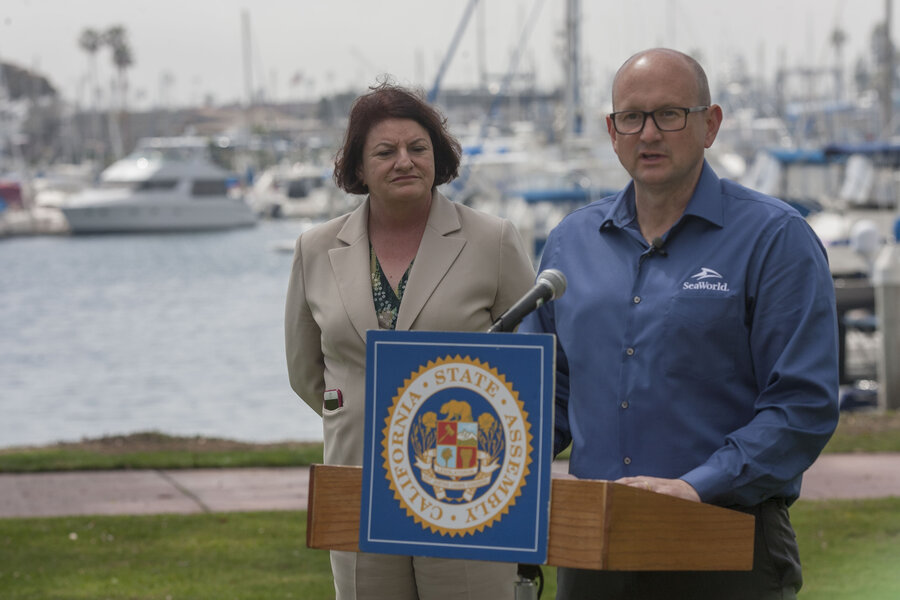Will SeaWorld still be SeaWorld without killer whales?
Loading...
| ORLANDO, Fla.
SeaWorld built its brand on a leaping and splashing killer whale named Shamu. She was part of its logo, gave her name to stadiums in the theme parks and was the inspiration for rides. The orca image sold T-shirts and soft, stuffed animals for the kids to take home.
With the company phasing out its killer whale program, it is forced to ponder the question: What is SeaWorld without Shamu?
"The orcas were their most powerful engagement tool," said Allen Adamson, a marketing and branding expert based in New York. "It requires SeaWorld to reinvent its core signature attraction. It's not an easy fix."
Under unrelenting pressure from animal rights groups and suffering from a drop in ticket sales, SeaWorld announced Thursday it was ending its orca breeding program and stopping its traditional killer whale shows.
SeaWorld isn't the only company to lose a signature and popular icon. Ringling Bros. and Barnum & Bailey Circus is retiring all its touring elephants to a 200-acre conservation center in May under similar pressure. And McDonald's phased out its "supersized" menu following the 2004 documentary, "Super Size Me," in which filmmaker Morgan Spurlock chronicled the effects of the chain's food on his health.
But McDonald's didn't go as far as SeaWorld, said Debanjan Mitra, branding expert at the University of Florida's Warrington College of Business.
"A comparable situation would be if McDonald's says, 'Tomorrow we are taking down the Big Mac.' That didn't happen," Mitra said.
SeaWorld's decision followed a backlash from the 2013 documentary "Blackfish," which told the story of Tilikum, an orca responsible for the death of a SeaWorld trainer in 2010 and two other people in the 1990s. Attendance at SeaWorld's parks in San Diego, Orlando and San Antonio declined and some top musical acts dropped out of SeaWorld-sponsored concerts at the urging of animal rights activists, who demonstrated outside the parks' gates.
SeaWorld's 29 killer whales — ranging in age from 1 to 51 years old — will remain in captivity, but in "new, inspiring natural orca encounters," according to the company. And, eventually, as they die off, the parks will have to figure out a way to attract visitors without them.
"It's hard to walk away from such a powerful icon, but they have no choice," said Laura Ries, a marketing consultant based in Atlanta. "Are they really going to hang their brand on this visual that is really problematic and makes people question what they are doing with animals?"
Whether the iconic killer whale images survive remains to be seen. Shamu already started fading from view when Southwest Airlines dropped its marketing partnership with SeaWorld in 2014. Experts said the orca imagery is inconsistent with SeaWorld's new focus.
"Imagery nostalgia can connect their audience in some way— that is part of their past, but it can't be part of their live future," Ries said.
SeaWorld Entertainment CEO Joel Manby said the company has a good story to tell about its marine animal rescue operations. "I feel like that's where we need to go as an organization and eliminate this orca issue as a cloud over our great story," he told The Associated Press.
Is that a story that will attract visitors?
Theme park consultant Dennis Speigel said SeaWorld now has the opportunity to return to its roots as a marine life park and enhance its position as an alternative theme park experience for people taking a break from Disney or Universal parks.
The Orlando park is getting a new roller coaster this year, but rides won't be the company's future, Speigel said.
"You'll see less of that in the future. You'll see capital dollars spent in the attractions area that focuses them back on marine life science and a really rich educational aspect," Speigel said.
Other experts caution that education might not attract crowds seeking thrills. People don't expect to visit an aquarium when they visit SeaWorld, and the company's previous plans to expand its orca tanks didn't placate the public, said Arun Sharma, professor of marketing at the University of Miami School of Business Administration.
"They will have to create experiences that differentiate themselves, as Universal does with Harry Potter or Disney does with Star Wars," Sharma said. "Education itself is not very attractive."
Overall, marketing experts say SeaWorld is making a positive change. In response, SeaWorld's stock shot up more than 16 percent by Friday afternoon.
___
Kay reported from Miami.







